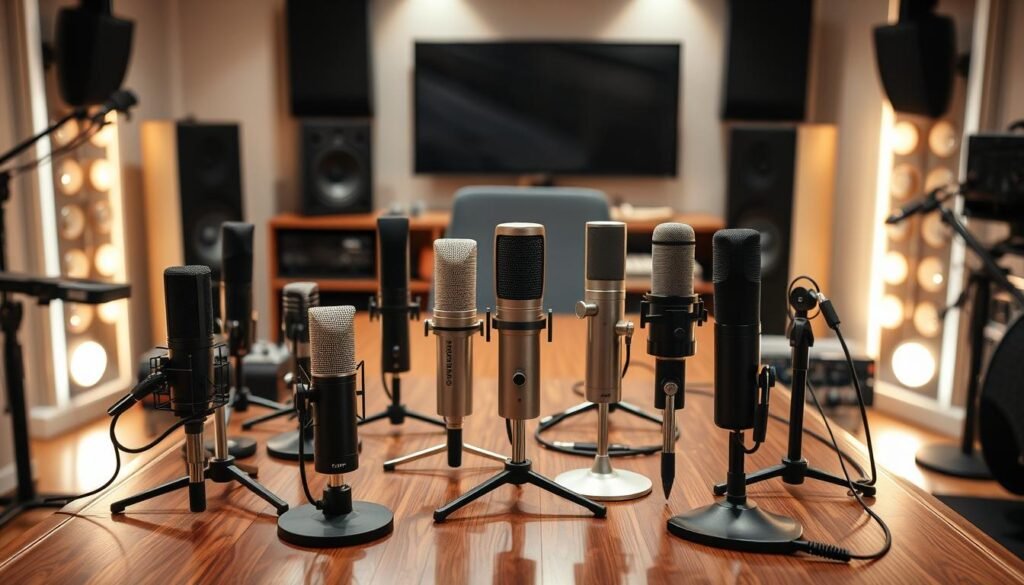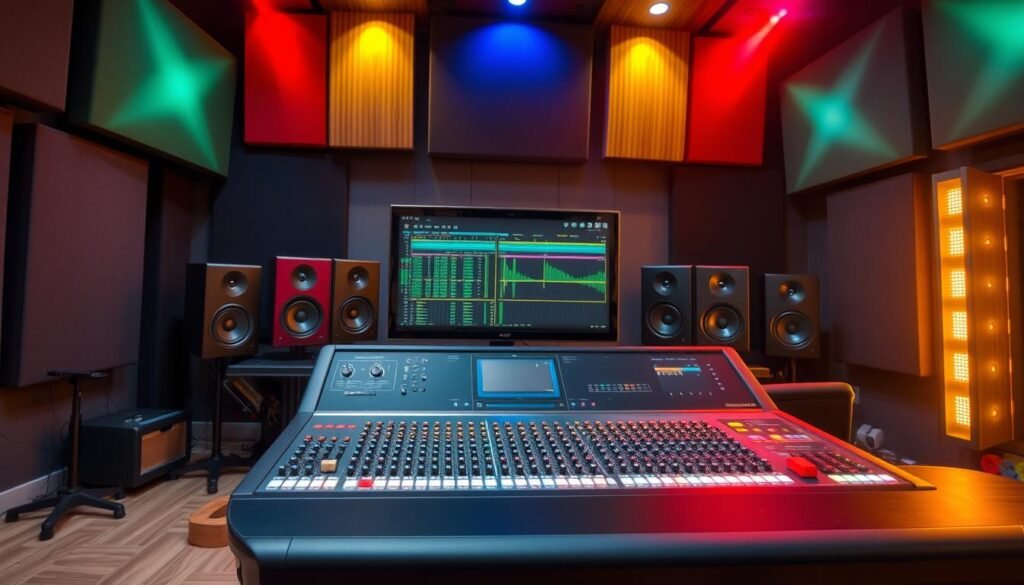ציוד אודיו באיכות גבוהה הוא חיוני לייצור סאונד מקצועי. זה חשוב גם לסטודיו ביתיים ולהופעות חיות כאחד. הציוד הנכון יכול לשפר באופן משמעותי את בהירות והעומק של הסאונד שלך.
כאשר אתה בוחר ציוד אודיו, חשוב לשקול את תגובת התדרים וטווח הדינמיות. יחס הסיגנל לרעש גם חשוב. הגורמים הללו קובעים כמה טוב הציוד שלך יוכל ללכוד ולשחזר סאונד.
אנו נחקור במאמר זה רכיבי ציוד אודיו חיוניים. זה כולל מיקרופונים, ממירי אודיו ומוניטורים לסטודיו. נחלוק גם את הבחירות המובילות בכל קטגוריה.
הבנת ציוד אודיו באיכות היא קריטית לכל מי שיוצר סאונד. זה עוזר לך לקבל החלטות חכמות בבניית ההתקנה שלך. הידע הזה ערכי גם למתחילים וגם למקצוענים מנוסים.
מסקנות מרכזיות
- ציוד אודיו מקצועי חיוני להשגת סאונד באיכות גבוהה בהקלטות בסטודיו ובהופעות חיות.
- שקול את תגובת התדרים, טווח הדינמיות ויחס הסיגנל לרעש בעת בחירת ציוד אודיו.
- רכיבים עיקריים של ציוד אודיו מקצועי כוללים מיקרופונים, ממירי אודיו ורמקולים לאולפן.
- השקעה בציוד אודיו מרשים יכולה לשפר באופן משמעותי את בהירות, העומק וההשפעה של הצליל שלך.
- הבנת הרכיבים המרכזיים של ציוד אודיו באיכות גבוהה היא חיונית לקבלת החלטות מושכלות בעת בניית ההתקנה שלך.
רכיבים עיקריים של ציוד אודיו מקצועי
יצירת הקלטות אודיו באיכות גבוהה מחייבת את הציוד האודיו המקצועי הנכון. כל רכיב משמש תפקיד קריטי באיכות הצליל הכוללת. בואו נגלה את הרכיבים המרכזיים של התקנת אודיו מקצועית.
מיקרופונים: כידון צליל בבהירות
מיקרופונים הם חיוניים בכל התקנת הקלטה אודיו מקצועית. הם ממירים אנרגיה אקוסטית לאותות חשמליים. זה מאפשר לך להקליט קולות, כלי נגינה ומקורות אודיו אחרים בבהירות.
קיימים מספר סוגים של מיקרופונים, כל אחד עם תכונות ייחודיות. מיקרופונים קונדנסר מצוינים בהקלטת קולות וכלי נגינה אקוסטיים. הם מקליטים פרטים מורכבים ברגישות גבוהה.
מיקרופונים דינמיים מכונים על עמידות וגמישות. הם מושלמים להקלטת מקורות קול רועמים כמו תופים ומגברים.
ממשקי קול: חיבור ציוד למחשב שלך
ממשקי קול חוצים את הפער בין המיקרופונים והמחשב שלך. הם ממירים אותות אנלוגיים לנתונים דיגיטליים עבור תוכנות הפקת קול. ממשק באיכות גבוהה מבטיח העברת צליל נקי ומספק כניסות ויציאות נחוצות.
כאשר בוחרים ממשק, חשוב לשקול את מספר הכניסות והיציאות הנדרשות. כדאי לבדוק את שיעורי הדגימה הנתמכים, עומק הביטים ואיכות הצליל הכוללת. נמוך לטנציה חשובה למעקב והקלטה בזמן אמת.
רמקולי סטודיו: שחזור סאונד מדויק
רמקולי סטודיו אמינים הם חיוניים להחלטות מיקס ומאסטרינג מושכלות. להבדיל מרמקולים לצרכן, הם מספקים שחזור סאונד מדויק ולא מצובע. רמקולי סטודיו נועדו לספק תגובת תדר פלטה.
כדאי לשקול את גודל המרחב להקלטה וסוג המוזיקה בעת בחירת רמקולים. רמקולי קרבה עובדים טוב בסטודיוים קטנים. הם מספקים צליל ממוקד כאשר מונחים קרוב למאזין.
רמקולי שדה אמצע או רחוק עשויים להתאים לחדרים גדולים יותר או לערבובים רחבים יותר. השקעה בציוד איכותי חיונית לקבלת צליל מעולה. בחרו ברכיבים בזהירות כדי ליצור הפקות שמע מקצועיות.
המיקרופונים המובילים להקלטה מקצועית
בחירת המיקרופון הנכון חיונית להקלטת שמע מקצועית. מיקרופונים שונים מצליחים בלכידת מקורות שמע שונים. בואו נגלות את המיקרופונים המובילים להקלטת שירה, ביצוע דינמי וטונים חלקים.
מיקרופונים קונדנסר להקלטת שירה
מיקרופונים קונדנסר הם בחירה מובילה ללכידת שירה באולפני הקלטות מקצועיים. הם מציעים רגישות יוצאת דופן ומקליטים פרטים מורכבים בקול של זמר.
ה-Neumann U87 הוא מיקרופון אגדי לאולפן המשמש במספר לא סופי של רשומות מוצלחות. הוא מספק צליל חם ומלא עם בהירות ונוכחות מעולה.
ה-Shure SM7B הוא מיקרופון דינמי פופולרי בקרב זמרים ופודקאסטרים. הוא מספק צליל חלק ומאוזן ופינוי מעולה של קול מחוץ לציר בסביבות אקוסטיות שאינן אידיאליות.
מיקרופונים דינמיים לביצועים רב-תכליתיים

מיקרופונים דינמיים הם העבודה הכוחה בעולם האודיו המקצועי. הם מכונים על בנייתם העמידה ועל יכולתם לטפל ברמות לחץ של צליל גבוהות. ה-Shure SM57 הוא דוגמה קלאסית המשמשת כבר עשורים.
ה-SM57 נהוג לשימוש בהקלטת סאונד של גיטרה, תוף סנר, ושירה. התבנית הפולארית הצמודה שלו תופסת מקורות רעש בבהירות ובחוזקה.
מיקרופונים דינמיים מצוינים נוספים כוללים את ה-Sennheiser MD 421 וה-Electro-Voice RE20. שניהם נחשבים בגידול על ידי המומחים עבור הגמישות והביצועים האמינים.
מיקרופוני ריבון לצלילים חמים וחלקים
מיקרופוני ריבון מצוינים על ידי הצליל החלק, החם והטבעי שלהם. הם מצוינים בלכידת הרמוניקות עשירות של כלי נגינה אקוסטיים כמו מיתרים, כלי נשיפה וכלי עץ.
ה-Royer R-121 הוא מיקרופון ריבון מודרני המציע צליל מאוזן ומפורט עם קצה עליון חלק. הוא נהנה לשימוש תקליטני גיטרות חשמליות, תקליטני תופים ושירה.
ה-AEA R44 מחדש את מיקרופון הריבון הקלאסי RCA 44. הוא מספק צליל מושרה בהשראת וינטאג', עם טווח אמצע עשיר וקצוות חלקים לכלי נגינה אקוסטיים.
| סוג המיקרופון | תכונות | דגמים מומלצים |
|---|---|---|
| קונדנסר | רגישות גבוהה, יודע ללכוד פרטים קטנים, אידיאלי לשירה | Neumann U87, Shure SM7B |
| דינמי | עמיד, מתמודד עם SPL גבוה, רב תכליתי לכלי נגינה שונים | Shure SM57, Sennheiser MD 421, Electro-Voice RE20 |
| ריבון | צליל חלק וחם, מתקדם בלכידת כלי נגינה אקוסטיים | Royer R-121, AEA R44 |
שקול את צרכי ההקלטה המסוימים שלך כאשר בוחר מיקרופונים עבור הסטודיו המקצועי שלך. שילוב של מיקרופונים איכותיים מסוג קונדנסר, דינמי וריבון מציע גמישות למקורות שונים.
השילוב הזה יכול לצייד אותך ללכידת שמע מצוינת בטווח רחב. ממיקרופונים להקלטת קולות עד מיקרופונים לכלי נגינה, תהיה מוכן להקלטות ברמה מקצועית.
בחירה זריזה של מיקרופוני סטודיו תעזור לך להציג את הפוטנציאל האמיתי של הציוד השמע שלך. בחר בחוכמה כדי ליצור הקלטות מצטיינות בסטודיו שלך.
ציוד שמע מקצועי: ציוד לערבוב ולמיקסג
ציוד ערבוב ומיקסג איכותי הוא חיוני לצליל מקצועי בהקלטות שמע. קונסולות מיקסג שמע מערבבות מספר אותות בדיוק. קונסולות סופר-איכותיות כמו SSL AWS 948 ו-Neve 1073DPX הן בחירות מובילות בקרב מקצוענים.
כלי למיקסג שמע מסיימים את ההקלטות ווודאים רמות ואיזון טונאלי עקביים. קומפרסורים, משוואים ולימיטרים ברמת מיקסג הם חיוניים להשפעה מקצועית. ה-Manley Massive Passive EQ וה-Rupert Neve Designs Portico II הן בחירות פופולריות.

תוספי תוכנה זכו בפופולריות בשנים האחרונות. הם מציעים עיבוד איכותי בפורמט נוח. תוספים כמו Waves SSL 4000 Collection ו-Fab Filter Pro-Q 3 מספקים מגוון אפשרויות.
הכלים הדיגיטליים הללו מתאימים היטב לזרימות עבודה של אודיו מודרניות. הם מאפשרים למהנדסים לעצב ולשפר את המיקסים והמאסטרים שלהם בצורה יעילה.
"השקעה בציוד מיקסור ומאסטרינג מצוין היא חיונית לכל מהנדס אודיו מקצועי. הכלים הללו מאפשרים לנו ליצור הקלטות שמתגברות ומתחרות עם הטובים ביותר בתעשייה." – מפיק ומהנדס זוכה פרס ה-Grammy, סטיב ג'נוויק
שקול אפשרויות ציוד חומרה ותוכנה כאשר בונים את ההתקנה האודיו המקצועית שלך. שילוב של ציוד אנלוגי עם תוספי דיגיטליים יוצר מערכת עוצמתית. הגישה הגמישה הזו עומדת בדרישות הייצור האודיו המודרני.
בניית הגדרת האודיו המקצועית שלך
הגדרת אודיו מקצועית דורשת יותר ממיקרופונים ומממשקים. עליך לשקול את כל השרשרת האודיו ו. כבלים וחיבורים איכותיים הם חיוניים גם עבור ביצוע סאונד אופטימלי.
יצירת שרשרת אודיו יעילה
היא המפתח לשמירה על איכות הסאונד ולהפחתת הרעש. עדיף לארגן את הציוד שלך בצורה לוגית כדי להבטיח העברת סיגנל נקי. עליך להשתמש בפריאמפים איכותיים כמו Grace Design m101 ו-Rupert Neve Designs 511 על מנת לשפר את הסאונד.
סטייג'ינג נכון של הגיין הוא חיוני להשגת איכות סאונד מיטבית. זה עוזר למנוע איכול ולשמור על יחס סיגנל לרעש חזק במהלך ההתקנה שלך.
טיפול אקוסטי לסאונד אופטימלי
היא חיונית להקלטות ברמה מקצועית. עליך להשתמש בפאנלים אקוסטיים ומפזרים ממותגים כמו Auralex כדי להפחית השתקות לא רצויה. הטיפול הזה עוזר לשלוט ברעשים חיצוניים וליצור סביבת סאונד מדויקה יותר.
מרחב שטוח מאפשר החלטות טובות יותר בעריכה ובמיקס. זה מספק סביבת האזנה נייטרלית, החיונית ליצירת הקלטות מאוזנות ומלוטשות.
כבלים וחיבורים: הגיבורים השכחים
כבלים וחיבורים באיכות גבוהה הם חיוניים להגדרת האודיו שלך. כבלים ממותגים כמו Mogami ו-Canare מפחיתים אובדן אות והפרעות. השקעה בכבלי אודיו אמינים מבטיחה אותות טהורים לאורך תהליך ההקלטה.
רכיבים אלו שנעלמים לעיתים קרובות משפיעים באופן משמעותי על המקצב הכללי של הצליל שלך. הם עוזרים לשמור על תקינות האות מהמקור ליעד, שומרים על איכות האודיו שלך.



